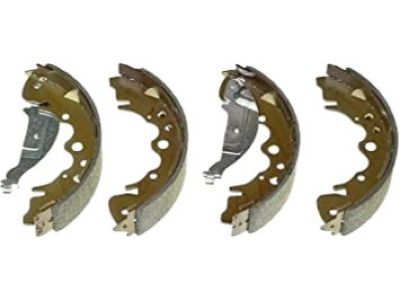Whenever the brake shoes are replaced, the return and hold-down springs should also be replaced due to the continuous heating and cooling cycle that can cause the springs to lose tension over time, potentially allowing the shoes to drag on the drum and wear more quickly. Begin by loosening the wheel lug nuts, raising the rear of the vehicle, and securely supporting it on jackstands while blocking the front wheels. Remove the rear wheels, release the parking brake, and loosen the parking brake cable adjuster to create slack. Pull off the brake drums, which may be difficult if the shoes have excessively worn the drums; if necessary, use a brake adjuster tool to retract the shoes. Thoroughly wash the brake assembly with brake system cleaner, avoiding compressed air. Clean the brake drums, checking for score marks, deep grooves, hard spots, and cracks; if worn, they can be resurfaced by an automotive machine shop, and professionals recommend resurfacing whenever a brake job is done. Work on one drum brake assembly at a time, using the other as a reference if needed. Use a hold-down spring tool to disconnect the hold-down cups and remove the hold-down springs, then disconnect the lower shoe return spring and remove the leading and trailing shoes along with the adjuster mechanism. Disconnect the parking brake cable from the lever, place the brake shoe and adjuster assembly on a workbench, and remove the remaining parts. Inspect and replace the wheel cylinder if necessary, clean the backing plate, and apply brake grease to the raised pads, slots in the wheel cylinder pistons, and ends of the lower shoe retaining plate. Apply grease to the adjuster's threaded portion and tips, engage the slots in the brake shoes, and attach the upper return spring to hold them in place. Position the shoes and adjuster on the backing plate, engaging the upper ends of the shoes with the wheel cylinder pistons, then attach the lower return spring. Install the hold-down pins, springs, and cups, and repeat the procedure for the other rear brake assembly. Install the brake drums, adjusting the brake shoes until the drum stops turning, then backing off slightly to ensure the wheel turns freely without dragging. Adjust the parking brake cable, install the wheels and lug nuts, lower the vehicle, and tighten the lug nuts to the specified torque, testing the brakes for proper operation before driving.
Posted by KiaPartsNow Specialist 








